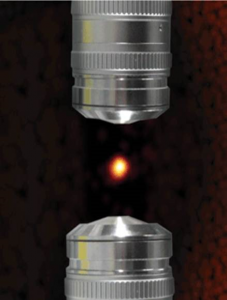Here you can find an overview of a few of the research projects I have worked on between 2010 and 2015. For further information or if you have any questions, please do not hesitate to contact me.
4Pi-RESOLFT nanoscopy
 From 2011 to 2015, I did my Ph.D. studies in the Department of NanoBiophotonics at the Max Planck Institute for Biophysical Chemistry of Prof Stefan Hell in Göttingen, Germany. In his department, physicists, biologists, chemists, and engineers conceive, invent and utilize optical microscopes with a resolution at the nanometer scale to advance life sciences.
From 2011 to 2015, I did my Ph.D. studies in the Department of NanoBiophotonics at the Max Planck Institute for Biophysical Chemistry of Prof Stefan Hell in Göttingen, Germany. In his department, physicists, biologists, chemists, and engineers conceive, invent and utilize optical microscopes with a resolution at the nanometer scale to advance life sciences.
The major technique used to achieve this goal is Stimulated Emission Depletion (STED) Microscopy. Besides STED in various forms, 4Pi Microscopy is also used and further developed. While STED can overcome the diffraction barrier down to 5 nm in the lateral direction, 4Pi Microscopy can increase the resolution in the axial direction by using two opposing lenses.
Both techniques have already been combined successfully to create isotropic diffraction-unlimited point spread functions. Nevertheless, the usage of high laser intensities should be avoided when imaging living cells.
My doctoral research was about the development of a new super-resolution technique for the three-dimensional visualization of living biological structures and their dynamics at low light levels – 4Pi-RESOLFT nanoscopy. The developed microscopy approach combines two fluorescence microscopy techniques: REversible Saturable OpticaL Fluorescence Transitions (RESOLFT) Microscopy and 4Pi Microscopy.
My Ph.D. thesis project resulted in the following paper:
- Boehm U., Hell S. W., Schmidt R. (2016): “4Pi-RESOLFT nanoscopy”
Nature Comm. 7 (10504), 1 – 8
3D in situ imaging of block copolymers nanostructures with the isoSTED
This project resulted in the following paper:
- Ullal C.K., Primpke S., Schmidt R., Boehm U., Egner A., Vana P, Hell S.W. (2011): “Flexible Microdomain Specific Staining of Block Copolymers for 3D Optical Nanoscopy” Macromolecules, 44, p7508–7510, doi: 10.1021/ma201504f
Imaging synaptic vesicles release of neurotransmitter with the isoSTED
This project resulted in the following paper:
- Wilhelm B.G, Groemer T.W., Rizzoli S.O. (2010): “The same synaptic vesicles drive active and spontaneous release” Nature Neuroscience. 13(12):1454-6. doi: 10.1038/nn.2690
For further information or if you have any questions, please do not hesitate to contact me.